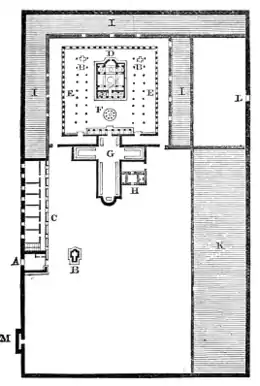Santa Laura, Mount Athos.
The necessity for defence from hostile attacks, economy of space and convenience of access from one part of the community to another, by degrees dictated a more compact and orderly arrangement of the buildings of a monastic coenobium. Large piles of building were erected, with strong outside walls, capable of resisting the assaults of an enemy, within which all the Santa Laura, Mount Athos.necessary edifices were ranged round one or more open courts, usually surrounded with cloisters. The usual Eastern arrangement is exemplified in the plan of the convent of Santa Laura, Mount Athos (Laura, the designation of a monastery generally, being converted into a female saint).
This monastery, like the oriental monasteries generally, is surrounded by a strong and lofty blank stone wall, enclosing an area of between 3 and 4 acres. The longer side extends to a length of about 500 feet. There is only one main entrance, on the north side (A), defended by three separate iron doors. Near the entrance is a large tower (M), a constant feature in the monasteries of the Levant. There is a small postern gate at L. The enceinte comprises two large open courts, surrounded with buildings connected with cloister galleries of wood or stone. The outer court, which is much the larger, contains the granaries and storehouses (K), and the kitchen (H) and other offices connected with the refectory (G). Immediately adjacent to the gateway is a two-storied guest-house, opening from a cloister (C). The inner court is surrounded by a cloister (EE), from which open the monks’ cells (II). In the centre of this court stands the catholicon or conventual church, a square building with an apse of the cruciform domical Byzantine type, approached by a domed narthex. In front of the church stands a marble fountain (F), covered by a dome supported on columns. Opening from the western side of the cloister, but actually standing in the outer court, is the refectory (G), a large cruciform building, about 100 feet each way, decorated within with frescoes of saints. At the upper end is a semicircular recess, recalling the triclinium of the Lateran Palace at Rome, in which is placed the seat of the hegumenos or abbot. This apartment is chiefly used as a hall of meeting, the oriental monks usually taking their meals in their separate cells.
 |
A. Gateway.
B. Chapels. C. Guest-house. D. Church. E. Cloister. F. Fountain. G. Refectory. H. Kitchen. I.Cells. K. Storehouses. L. Postern gate. M.Tower. |
| Fig. 1.—Monastery of Santa Laura, Mount Athos (Lenoir). | |